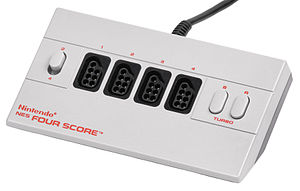NES Four Score
NES Four Score
Jump to navigation
Jump to search
 | |
| Developer | Nintendo |
|---|---|
| Manufacturer | Nintendo |
| Type | Multitap |
| Generation | Third generation |
| Release date | 1990 (1990) |
| Input | NES controller port |
| Controller input | NES controllers |
| Platform | Nintendo Entertainment System |
| Backward compatibility | All NES games (1 or 2 players) |
The NES Four Score is a multitap accessory created by Nintendo in 1990 for the Nintendo Entertainment System. Select games can utilize it to enable up to four-player gameplay.[1] The NES Four Score is similar to the previously introduced NES Satellite, a device that allows four players to connect to the NES and extends the range using infrared wireless communication.
Prior to the advent of multitap support on NES, the NES games which support more than two players, require the players to pair up and then alternate turns while sharing the same pair of NES controllers. Some games that originally feature support for more than two players, such as some arcade games, support only two simultaneous players in their NES versions.
On the NES Four Score, there is an option to switch between two-player and four-player modes, and there are turbo A and B buttons that give any of the connected controllers a rapid fire boost. The NES Four Score can also be used as a controller extension cable because the wire which leads from the accessory to the NES is several feet in length.[2]
Contents
1 Games
2 4-Players Adaptor
2.1 Games
3 References
4 See also
Games[edit]
These games are compatible with the NES Four Score, for more than two concurrent players.
- Bomberman II
- Danny Sullivan's Indy Heat
- Gauntlet II
- Greg Norman's Golf Power
- Harlem Globetrotters
- Justice Duel
Kings of the Beach [3]
- Magic Johnson's Fast Break
- Monopoly
- Monster Truck Rally (video game)
- M.U.L.E.
- NES Play Action Football
A Nightmare on Elm Street [4]
Nintendo World Cup [5]
- R.C. Pro-Am II
- Rackets & Rivals
- Rock 'n Ball
- Roundball: 2 on 2 Challenge
- Spot: The Video Game
- Smash TV
- Super Off Road
- Super Jeopardy!
- Super Spike V'Ball
- Swords and Serpents
- Top Players' Tennis
4-Players Adaptor[edit]
The 4-Players Adaptor (Japanese: 4人プレイヤーズアダプタ) is a licensed peripheral released for the Famicom in Japan by Hori.[6] It is the Famicom's equivalent to the NES Four Score.[7] Its purpose is to allow up to four players to play simultaneously in compatible games by allowing for additional controllers to be connected through the console's expansion port. The adapter also features a switch that allows the first two players to use external controllers in lieu of the standard Famicom controllers, giving each player the choice to use an external controller. Many of the titles in Technōs Japan's Kunio-kun series support the adapter.
Games[edit]
- Downtown Nekketsu Kōshinkyoku: Soreyuke Daiundōkai
- Ike Ike! Nekketsu Hockey Bu: Subette Koronde Dai Rantō
- Moero TwinBee: Cinnamon-hakase o Sukue! (3-players)
- Nekketsu Kakutō Densetsu
- Nekketsu Kōkō Dodge Ball Bu
- Nekketsu Street Basket: Ganbare Dunk Heroes
- Kunio-kun no Nekketsu Soccer League
- U.S. Championship V'Ball
- Wit's
References[edit]
^ "Nintendo Entertainment System Accessories". Giant Bomb. October 22, 2013..mw-parser-output cite.citation{font-style:inherit}.mw-parser-output q{quotes:"""""""'""'"}.mw-parser-output code.cs1-code{color:inherit;background:inherit;border:inherit;padding:inherit}.mw-parser-output .cs1-lock-free a{background:url("//upload.wikimedia.org/wikipedia/commons/thumb/6/65/Lock-green.svg/9px-Lock-green.svg.png")no-repeat;background-position:right .1em center}.mw-parser-output .cs1-lock-limited a,.mw-parser-output .cs1-lock-registration a{background:url("//upload.wikimedia.org/wikipedia/commons/thumb/d/d6/Lock-gray-alt-2.svg/9px-Lock-gray-alt-2.svg.png")no-repeat;background-position:right .1em center}.mw-parser-output .cs1-lock-subscription a{background:url("//upload.wikimedia.org/wikipedia/commons/thumb/a/aa/Lock-red-alt-2.svg/9px-Lock-red-alt-2.svg.png")no-repeat;background-position:right .1em center}.mw-parser-output .cs1-subscription,.mw-parser-output .cs1-registration{color:#555}.mw-parser-output .cs1-subscription span,.mw-parser-output .cs1-registration span{border-bottom:1px dotted;cursor:help}.mw-parser-output .cs1-hidden-error{display:none;font-size:100%}.mw-parser-output .cs1-visible-error{font-size:100%}.mw-parser-output .cs1-subscription,.mw-parser-output .cs1-registration,.mw-parser-output .cs1-format{font-size:95%}.mw-parser-output .cs1-kern-left,.mw-parser-output .cs1-kern-wl-left{padding-left:0.2em}.mw-parser-output .cs1-kern-right,.mw-parser-output .cs1-kern-wl-right{padding-right:0.2em}
^ "NES Four Score adapter converted for USB use". Retro Game Network. April 22, 2013. Retrieved January 4, 2014.
^ "Kings of the Beach (NES)". NintendoLegend.
^ "Retro Gaming Review: A Nightmare on Elm Street (NES)". Daily Dead. July 15, 2011.
^ "Nintendo World Cup Review". allgame.
^ "Nintendo Entertainment System / Famicom Documentation". Mednafen. September 12, 2013.
^ "Famicom Four Player Adapter". Famicom World. February 16, 2011.
See also[edit]
- NES Satellite
- Multitap
- List of Nintendo Entertainment System accessories
Categories:
- Nintendo Entertainment System accessories
- Computer-related introductions in 1990
(window.RLQ=window.RLQ||).push(function(){mw.config.set({"wgPageParseReport":{"limitreport":{"cputime":"0.348","walltime":"0.449","ppvisitednodes":{"value":1293,"limit":1000000},"ppgeneratednodes":{"value":0,"limit":1500000},"postexpandincludesize":{"value":73530,"limit":2097152},"templateargumentsize":{"value":1070,"limit":2097152},"expansiondepth":{"value":12,"limit":40},"expensivefunctioncount":{"value":1,"limit":500},"unstrip-depth":{"value":1,"limit":20},"unstrip-size":{"value":16924,"limit":5000000},"entityaccesscount":{"value":0,"limit":400},"timingprofile":["100.00% 316.729 1 -total"," 39.26% 124.356 1 Template:Reflist"," 24.86% 78.730 1 Template:Cite_web"," 21.79% 69.001 1 Template:Infobox_information_appliance"," 15.66% 49.587 7 Template:Navbox"," 13.93% 44.114 1 Template:Infobox"," 10.55% 33.408 1 Template:Use_mdy_dates"," 9.70% 30.715 1 Template:Nihongo"," 9.06% 28.709 6 Template:Citeweb"," 7.20% 22.816 1 Template:Category_handler"]},"scribunto":{"limitreport-timeusage":{"value":"0.137","limit":"10.000"},"limitreport-memusage":{"value":4036446,"limit":52428800}},"cachereport":{"origin":"mw1239","timestamp":"20181026163214","ttl":1900800,"transientcontent":false}}});mw.config.set({"wgBackendResponseTime":561,"wgHostname":"mw1239"});});
